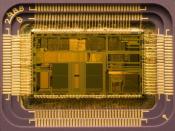The Pentium 4 processor, which has recently become available, is the latest in a long family of processors from Intel, that started with the 8088. Describe the development of this family. Compare the internal structures of the various members of the family and discuss the reasons for change.
The Pentium 4 processor was announced in a blaze of publicity in late 2000 by Intel. It is the newest member of the most successful (in terms of unit sold) computer processors ever. It's history can be traced back to what is generally considered the first ever microprocessor - Intel's 4004 designed in 1969, and, of course, the development of transistor chips which led to it. When IBM and it's competitors used the 8088 in the first PCs, the success of the architecture which Intel now likes to call IA-32 (for Intel Architecture 32 bit, although it began as a 16 bit architecture) was assured.
Recently there has been some question over the future of IA-32 whose insistence on backwards compatibility has created chips which are less efficient than rivals with more modern designs.
The 8086 was the first processor in the x86 family launched in mid 1978. All future members are backwards compatible with it. It used 16-bit registers and a 16-bit data bus with 20-bit addressing and had a clock speed of 5MHz. Like it's (incompatible) predecessors from Intel, it was mostly used for calculators and specialised but simple systems such as controlling traffic lights. A year later the 8088 was launched. It was identical to the 8086 except for its restricted 8-bit external data bus (like the 8086, 16-bits were used internally). The smaller data bus allowed the chip itself to be cheaper but also the hardware attached to it could be simpler making it the chip of choice...


